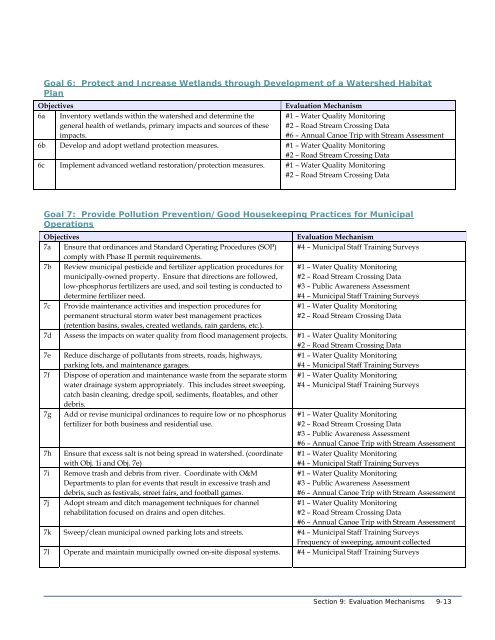Looking Glass River Watershed Management Plan - Greater ...
Looking Glass River Watershed Management Plan - Greater ...
Looking Glass River Watershed Management Plan - Greater ...
Create successful ePaper yourself
Turn your PDF publications into a flip-book with our unique Google optimized e-Paper software.
Goal 6: Protect and Increase Wetlands through Development of a <strong>Watershed</strong> Habitat<br />
<strong>Plan</strong><br />
Objectives<br />
Evaluation Mechanism<br />
6a<br />
Inventory wetlands within the watershed and determine the<br />
general health of wetlands, primary impacts and sources of these<br />
impacts.<br />
#1 – Water Quality Monitoring<br />
#2 – Road Stream Crossing Data<br />
#6 – Annual Canoe Trip with Stream Assessment<br />
6b Develop and adopt wetland protection measures. #1 – Water Quality Monitoring<br />
#2 – Road Stream Crossing Data<br />
6c Implement advanced wetland restoration/protection measures. #1 – Water Quality Monitoring<br />
#2 – Road Stream Crossing Data<br />
Goal 7: Provide Pollution Prevention/Good Housekeeping Practices for Municipal<br />
Operations<br />
Objectives<br />
Evaluation Mechanism<br />
7a Ensure that ordinances and Standard Operating Procedures (SOP)<br />
comply with Phase II permit requirements.<br />
#4 – Municipal Staff Training Surveys<br />
7b<br />
7c<br />
Review municipal pesticide and fertilizer application procedures for<br />
municipally-owned property. Ensure that directions are followed,<br />
low-phosphorus fertilizers are used, and soil testing is conducted to<br />
determine fertilizer need.<br />
Provide maintenance activities and inspection procedures for<br />
permanent structural storm water best management practices<br />
(retention basins, swales, created wetlands, rain gardens, etc.).<br />
#1 – Water Quality Monitoring<br />
#2 – Road Stream Crossing Data<br />
#3 – Public Awareness Assessment<br />
#4 – Municipal Staff Training Surveys<br />
#1 – Water Quality Monitoring<br />
#2 – Road Stream Crossing Data<br />
7d Assess the impacts on water quality from flood management projects. #1 – Water Quality Monitoring<br />
#2 – Road Stream Crossing Data<br />
7e Reduce discharge of pollutants from streets, roads, highways,<br />
parking lots, and maintenance garages.<br />
#1 – Water Quality Monitoring<br />
#4 – Municipal Staff Training Surveys<br />
7f Dispose of operation and maintenance waste from the separate storm<br />
water drainage system appropriately. This includes street sweeping,<br />
catch basin cleaning, dredge spoil, sediments, floatables, and other<br />
debris.<br />
#1 – Water Quality Monitoring<br />
#4 – Municipal Staff Training Surveys<br />
7g<br />
7h<br />
7i<br />
7j<br />
Add or revise municipal ordinances to require low or no phosphorus<br />
fertilizer for both business and residential use.<br />
Ensure that excess salt is not being spread in watershed. (coordinate<br />
with Obj. 1i and Obj. 7e)<br />
Remove trash and debris from river. Coordinate with O&M<br />
Departments to plan for events that result in excessive trash and<br />
debris, such as festivals, street fairs, and football games.<br />
Adopt stream and ditch management techniques for channel<br />
rehabilitation focused on drains and open ditches.<br />
#1 – Water Quality Monitoring<br />
#2 – Road Stream Crossing Data<br />
#3 – Public Awareness Assessment<br />
#6 – Annual Canoe Trip with Stream Assessment<br />
#1 – Water Quality Monitoring<br />
#4 – Municipal Staff Training Surveys<br />
#1 – Water Quality Monitoring<br />
#3 – Public Awareness Assessment<br />
#6 – Annual Canoe Trip with Stream Assessment<br />
#1 – Water Quality Monitoring<br />
#2 – Road Stream Crossing Data<br />
#6 – Annual Canoe Trip with Stream Assessment<br />
7k Sweep/clean municipal owned parking lots and streets. #4 – Municipal Staff Training Surveys<br />
Frequency of sweeping, amount collected<br />
7l Operate and maintain municipally owned on-site disposal systems. #4 – Municipal Staff Training Surveys<br />
Section 9: Evaluation Mechanisms 9-13





